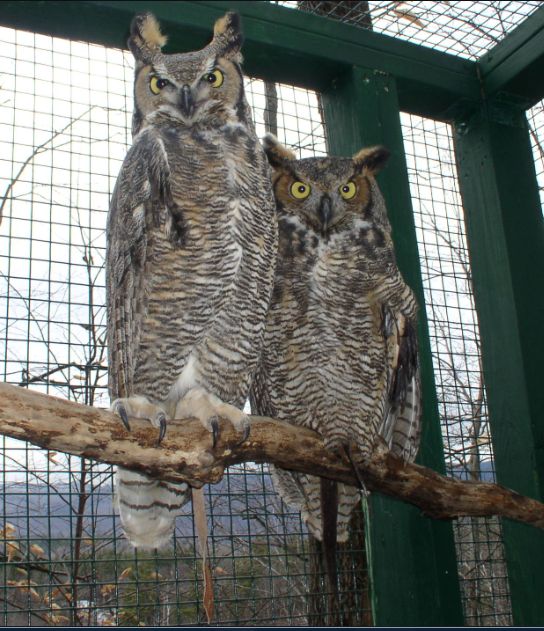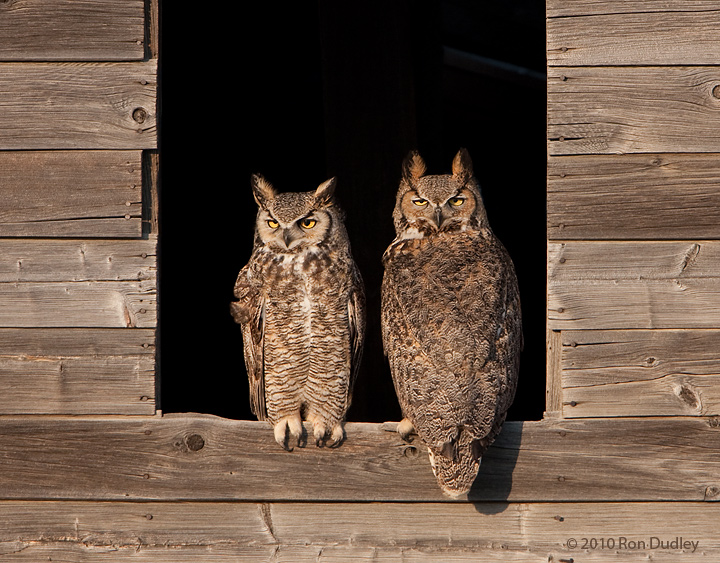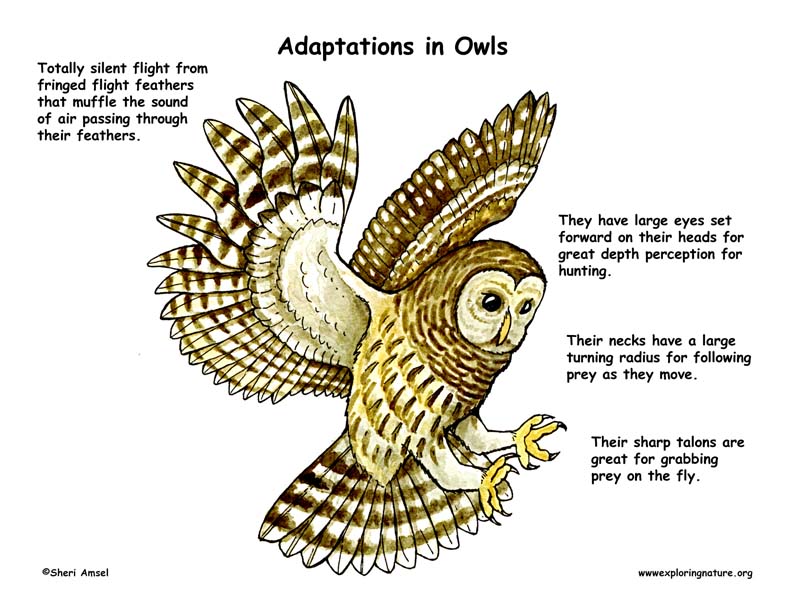Adaptation
The excellent visual acuity that owls possess allows them to be exceptional nocturnal hunters. The great horned owl’s pupils are very large, which allows superior night vision. However, their eyeballs themselves are so large, that the owls cannot roll them like humans can. Instead, they have to turn their whole head to see peripherally (Hall). They can turn their heads up to 270 degrees! (National Wildlife Federation 2014). Along with larger pupil and eyeball size, owls also have more retinal rods than humans. This means they are able to detect motion exceptionally better than we can (Hall).
 The great horned owl’s most distinguishable feature are their ear
tufts that resemble horns. These are simply feathers, which can
sometimes indicate mood, or even help camouflage the bird. However,
a greater adaptation beneath the tufts is the owl’s hearing. The
great horned owl, as well as many owls, have a remarkable sense of
hearing. They can hear sounds up to ten times quieter than we can.
They also have a unique system that allows them to capture prey
efficiently. Owls have facial disks, which help direct sound waves
to their ears. Their ears are hidden beneath the dark edges of the
facial disk. The owls’ right ear is positioned slightly higher than
their left ear, resulting in sound reaching one ear slightly before
it is heard by the other. Because of this, the owl tilts its head
until the sound waves align. Once the sounds equalize, because the
owl cannot move their eyes without turning their head, the owl is
staring directly at the prey making the noise (Hall). This
evolutionary adaptation in great horned owls of vertically
asymmetrical ears is one of the most rare structural features of the
owl’s auditory system, which increases their ability to focus on the
a sound stimulus regarding the elevation of the source
(Gutiérrez-Ibáñez et al. 2011).
The great horned owl’s most distinguishable feature are their ear
tufts that resemble horns. These are simply feathers, which can
sometimes indicate mood, or even help camouflage the bird. However,
a greater adaptation beneath the tufts is the owl’s hearing. The
great horned owl, as well as many owls, have a remarkable sense of
hearing. They can hear sounds up to ten times quieter than we can.
They also have a unique system that allows them to capture prey
efficiently. Owls have facial disks, which help direct sound waves
to their ears. Their ears are hidden beneath the dark edges of the
facial disk. The owls’ right ear is positioned slightly higher than
their left ear, resulting in sound reaching one ear slightly before
it is heard by the other. Because of this, the owl tilts its head
until the sound waves align. Once the sounds equalize, because the
owl cannot move their eyes without turning their head, the owl is
staring directly at the prey making the noise (Hall). This
evolutionary adaptation in great horned owls of vertically
asymmetrical ears is one of the most rare structural features of the
owl’s auditory system, which increases their ability to focus on the
a sound stimulus regarding the elevation of the source
(Gutiérrez-Ibáñez et al. 2011).
Although owls are not fast fliers, their flight is completely silent which is an excellent hunting adaptation. Unlike other birds who preen the ends of their wings so their feathers hook together, owls leave their feathers alone, leaving them soft and more spread out. With a top speed of about 40 mph, great horned owls can attack prey without making a sound. Silent flight is also advantageous regarding their hearing adaptation, so other sounds do not get in the way of their prey detection hearing techniques (Hall).
Another outstanding hunting adaptation that the great horned owl possesses are the talons. Their talons are opposable, and can vary from a perched position with three claws in the front and one in the back, to a hunting grip position, with two claws in the front and two in the back. The great horned owl’s grip is about 500 pounds of force per square inch. Their hunting grip frames its prey’s spine, and kills them almost instantly with their powerful grip (Hall).
Although they have no teeth, great
horned owls are still able to consume prey effectively. They swa llow
small prey, while using their sharp beaks and talons to tear larger
prey to edible sizes. Their forward talon has jagged edges, allowing them to tear more effectively. They also have horny pads underneath
their talons that help the owls control struggling prey while it
flies. Great horned owls often carry their prey to a safe perch to
eat so they do not get ambushed by other predators. Additionally,
great horned owls are the only bird of prey that can fly while
carrying something equal to them in weight (Hall).
llow
small prey, while using their sharp beaks and talons to tear larger
prey to edible sizes. Their forward talon has jagged edges, allowing them to tear more effectively. They also have horny pads underneath
their talons that help the owls control struggling prey while it
flies. Great horned owls often carry their prey to a safe perch to
eat so they do not get ambushed by other predators. Additionally,
great horned owls are the only bird of prey that can fly while
carrying something equal to them in weight (Hall).
An interesting potential adaptation that the great horned owls express is reversed sexual dimorphism. This common trait among birds of prey is when the females are larger than the males. Great horned owls are one of the most extreme species that exhibits this. Although not proven, it is hypothesized that this is due to the adaptive advantage for females to capture a wider range of larger prey, made possible by their increased size. Another hypothesis is that males have smaller body sizes in order to be more agile for hunting. A study conducted by William S. Longland examined both male and female pellets in a single habitat and found that females had an overall wider range of larger prey, tentatively supporting this hypothesis (Longland 1989).
